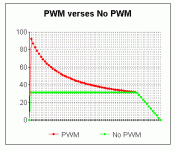Reid Welch
1 MW
Yes, Leg power is springy--it's the vital shock-buffer.
A motor, particularly a gear motor, represents a solid wall of power.
If we shift a dog-clutch transmission under so much unrelenting torque as will be supplied by a full-on gear motor (that's the worst scenario),
something's going to break in short order.
Even if the motor is only partially powered up, where's the shock buffer?
We'd need a slip clutch at the very least. Or a chain under spring loaded idler arm tension.
That'd be the best kluge, but still a kluge, because discrete shifting transmissions driven by hard motive sources need some sort of declutching
or buffering as per a chain tensioner on the power side.
my opinion.
A motor, particularly a gear motor, represents a solid wall of power.
If we shift a dog-clutch transmission under so much unrelenting torque as will be supplied by a full-on gear motor (that's the worst scenario),
something's going to break in short order.
Even if the motor is only partially powered up, where's the shock buffer?
We'd need a slip clutch at the very least. Or a chain under spring loaded idler arm tension.
That'd be the best kluge, but still a kluge, because discrete shifting transmissions driven by hard motive sources need some sort of declutching
or buffering as per a chain tensioner on the power side.
my opinion.







